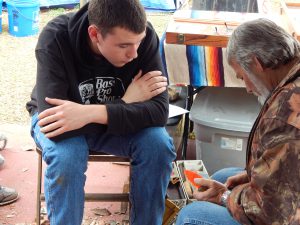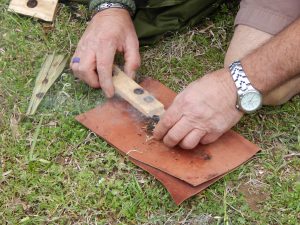
TUSCALOOSA, Ala. — The University of Alabama’s Moundville Knap-in, slated for March 11 and 12, is a great event for anyone interested in Native Americans, ancient technologies or outdoor sports such as hunting and fishing.
Held at Moundville Archaeological Park, 13 miles south of Tuscaloosa, stone toolmakers, artists and ancient technology experts from around the country hammer out stone points, carve intricate pieces, throw spears and shoot bows.
Children can get their faces painted, grind corn or play Native American games.
Flintknapping is an ancient technology used by nearly all Stone Age people. Native Americans made most of their weapons and many of their tools from stone prior to Europeans arriving in the New World.
Very quickly, native people set aside flintknapping in favor of metal implements to the point where the technology was almost lost. In the last 25 years, however, hundreds, if not thousands, of people have revived the process, passing their knowledge down from one person to another in much the same way as the ancients did.
Flintknapping is based on the principle of how glass breaks. Imagine what a windowpane looks like when it’s been shot with a BB pellet.
Where the BB goes into the pane the hole is small. As the pellet goes through the glass, a cone-shaped piece pops out. Using these laws of physics, knappers create any number of tools or weapons. Spear and arrow points, knives, scrapers, drills and spokeshaves are just a few things Indians from our area made using this technology.
There are about as many different ways to knap as there are flintknappers, experts said. Some knappers use only tools made out of stone or bone to fashion their points. Others use copper-covered, lead-weighted billets they call “boppers” to hammer on their stone. Lapidary knappers use rock saws and heavy duty electric grinders to preshape their pieces prior to removing flakes.

“Events such as the Moundville Knap-in connect us not only to our past, but also to our environment,” said Betsy Irwin, park Education Outreach Coordinator. “In this day and age of ‘technology,’ many young people don’t realize how we rely on the planet for everything we consume.
“We also want people to know that many ancient technologies are not ‘primitive.’ Flintknapping, for instance, takes a great deal of innate geometry into consideration. Knappers must calculate exactly how hard to hit a rock, where to strike it and at what angle. If he misinterprets any of these, he is likely to break the point he’s making.”
The event will include a children’s area, which will be open both days of the knap-in, where kids can make crafts, play games and have their faces painted.
Other outdoor demonstrations and displays include ancient hunting and fishing equipment, basketry and pottery firings. Visitors will also get a chance to test out a spear thrower or toss rabbit sticks in the nearby target range.
Juanita Gardinski, of the Mississippi Band of Choctaw Indians, is providing food concessions, including some longtime favorite Native American foods like frybread, Indian tacos, buffalo stew, catfish and hominy.
Other Choctaw crafts, such as basket making and bead work, will also be demonstrated, as will the Southeastern Indian tradition of shell carving. Premiere shell carver Dan Townsend, of Tallahassee, Florida, demonstrates, exhibits and sells his one-of-a-kind pieces.
Visitors over the age of 12 are encouraged to sit down and learn to make a stone point. All the tools needed, safety gear and rock are available for purchase. There is also a huge variety of stone points, knives, wooden display cases and other handmade items for sale.
For more information, phone 205/371-8732 or email llrasco@ua.edu.
Contact
Kim Eaton, UA media relations, 205/348-8325, kkeaton@ur.ua.edu
Source
Betsy Irwin, 205/371-8732, birwin@ua.edu